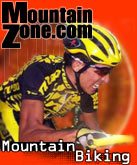
Border Crossing
Traversing the Andes by Mountain Bike
June 5, 2005

|
| A Winding Traverse Courtesy of Ralph Junghanns |
We were cruising when Denis spotted a little boy pushing his bike. Both his tires were flat.
"Hey Ralph, can we help that boy?" he asked.
"We' d need a 15-spanner, which, unfortunately, I don't have." Ralph told him.
But Denis didn't give up that easily. He asked the other bikers and Steffen, from the former Democratic Republic of Germany, had a suitable tool. He took both tires off and put new mountain bike tubes on. They were a bit too small, but Denis figured they were better than none. He also put the chain right and tightened it. After an hour, the small boy still didn't know what was happening to him, but he laughed and waddled away with a huge smile. Christmas in the midst of July.
In a nearby village we found, at last, the first phone to ring international destinations. Although the queue was long, they let me, the gringo with his helmet on, go first. As I phoned home, I watched the brown curious faces of villagers watching me with their noses pressed against the window.
After waiting four hours in the hot sun for the van, we were whisked into La Paz and a comfortable hotel. It was not a struggle any more for our sunburned faces. We had made it.
We spent a day in the vibrant city of La Paz, a city of amazing contrasts. and another on Lake Titicaca, which looks like a huge ocean (8,301 square kilometers and the world's highest navigable lake at 3,820 meters).
"We then descended more gradually along a river (which at one stage turned pink), through villages and alongside grazing llamas and alpacas..." |
After our well-earned rest we met Alistair, a Kiwi from Wellington, who is Bolivian vice champion in downhill riding. He owns Gravity, a company that exclusively offers awesome downhill rides in La Paz.
This time, no one had anything against the bus-ride up the 5,345m high Chacaltaya, the world's highest developed ski-field. The road—some may ask what road— became rougher and rougher, narrower and narrower, the abysses deeper and deeper, but the speed of the old bus definitely not slower! The first snow on the gravel piste caused some of the bikers to turn the same color. The bus sloped dangerously towards the precipice below and I made the driver stop. Robin was sure, we were all going to die.
At the finish, Al offered up beer—tasty and well earned. It had been a thrilling challenge and a whole lot of fun. We had found a worthy alternative to Kardung Leh. In all, it was an adventure never to be forgotten!
About the Author: Ralph Junghanns offers, together with his wife, cycling tours in New Zealand and, in addition, guides one or two tours overseas each year. Further tours on the program are: Mountain biking the Ho Chi Min Trail in Vietnam, through the oldest desert in Namibia, and a family tour through Patagonia. Ralph has been a New Zealand citizen since August 2002.